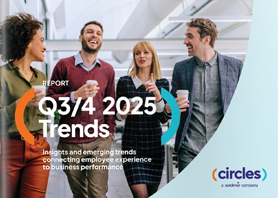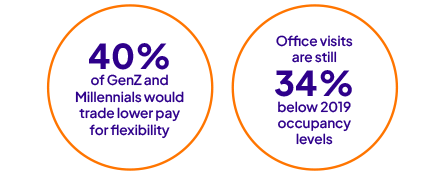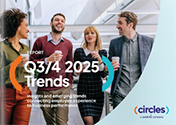
2025 Workplace Trends Report
Fresh insights. Real shifts. What’s next for the modern workplace.
Our latest trends report unpacks the second half of 2025 with six big shifts shaping how work gets done, why people stay and what it takes to thrive in a rapidly evolving landscape. What's inside:
-
Make the office a magnet, not a mandate – Discover six experience-first ways companies are turning the office into a place people want to be.
-
Gen Z to Boomers: It’s not one-size-fits-all – Learn how personalized strategies by generation are boosting engagement and retention.
-
Well-being is a business strategy now – See how leading orgs are measuring the ROI of well-being with targeted, high-impact programs.
-
Community: The unexpected retention driver – Explore how intentional connection is strengthening culture and cutting turnover.
-
Management is being redefined – Find out why today’s top managers lead with empathy, flexibility and whole-person support.
-
AI and culture: Where tech meets trust – Understand how smart orgs are using AI to enhance (not replace) human-centered culture.
And more!
Here's a preview: Trend #1 on Reimagining the Employee Experience


Making RTO appealing:
reimagining the employee experience
People leaders charged with implementing return-to-office (RTO) initiatives face a critical challenge: how to encourage employees to return to the office without relying on mandates. In a recent LinkedIn survey, 40% of Gen Z and millennial workers said they would accept lower pay for more flexibility about where they work. Across all generations, the share was 32%.
This signals a challenge to employers: reimagine the workplace not as somewhere employees have to visit but as a destination they want to experience.
And, to be clear, RTO is happening. Based on year-over-year figures, San Francisco experienced one of the largest increases in office traffic across all U.S. markets, behind only Boston and Washington, D.C. For 2024, office visit rates rose 10% from 2023, according to data analysis by Placer.ai. However, the same study found office visits are still 34% below 2019 trends. This suggests employers are making progress, yet there are more hurdles to overcome.
Beyond the traditional office
We see leading organizations pivot their approach to workplace excellence by considering physical environment and employee experience as complementary. The most successful companies on Fortune’s 100 Best Places to Work list — seven of which are Circles’ clients — have moved well beyond traditional office concepts in an effort to appeal to employees.
Take Walmart’s new Bentonville campus as a shining example. Set to fully open in 2025, the 350-acre headquarters is designed to feel more like a thriving community than a corporate hub. The campus will feature everything from restaurants and retail to childcare, a hotel, fitness centers and miles of bike trails. By blending work with everyday life, Walmart is creating a destination that supports the whole person, not just the employee. For people leaders, this exemplifies how reimagining office space can transform the workplace.
Creating destination workplaces
In our work with forward-thinking organizations, we’ve observed that successful workplace environments integrate physical, digital and cultural infrastructure — together, these efforts enable work to happen effectively and comfortably.
People leaders should consider:
Modern, purposeful office design with collaborative spaces balanced by quiet zones
On-site amenities that support daily needs and well-being
Spaces designed for connection including communal areas for spontaneous interaction
Welcome and workplace ambassadors with hospitality training who elevate daily experiences
Technology and tools that work seamlessly, with data collection that drives continuous improvement
Sustainable and healthy environments prioritizing employee wellness through thoughtful design
Workplace programming that builds community and provides value beyond individual work tasks


The differentiator: people-focused strategies
While exceptional physical spaces matter, we’re finding that organizations getting the best results are those looking beyond the environment to prioritize employees’ emotional, cultural and developmental journeys. For people and business leaders looking to differentiate their approach, we recommend these key focus areas:
- Culture of belonging and inclusion through intentional programs and community-building initiatives
- Mental, physical, and financial well-being support through comprehensive programming
- Flexibility and work-life integration that acknowledges individual needs
- Growth and career development opportunities that employees can’t access remotely
- Strong manager relationships built on empathetic leadership practices
- Purpose-driven engagement connecting office presence to broader impact and meaning

Case study: transforming the employee experience
We recently partnered with a global biopharma company to transform its employee experience during a headquarters relocation. Rather than mandating return-to-office, they created a culture prioritizing well-being and community engagement to naturally encourage hybrid work.
Leveraging Circles solutions, their strategy included a 24/7 concierge service for personal tasks, community management through farmers markets and team activities, and a personalized employee experience team enhancing daily interactions. What made this initiative successful wasn’t just the services themselves, but their delivery — executed with hospitality expertise specifically designed to make office attendance compelling rather than compulsory.
As a result, the organization saw employee satisfaction scores (eNPS) shoot up to 95, creating a headquarters that became both a talent attraction tool and community hub.

Shared accountability for employee experience
In our work with employers, we’ve found that creating exceptional workplaces requires more than executive directives. Successfully elevating employee experience can happen when responsibility is shared widely and baked into the culture. People leaders should cultivate this mindset across all organizational levels to maximize the impact.
We recommend encouraging team leaders to:
Champion flexible working arrangements while modeling in-office presence
Facilitate meaningful team connections during in-person time
Gather and implement feedback about office appeal factors
Recognize and accommodate diverse needs within teams

The care factor: supporting parents to strengthen workplace experience
Recent data from Coqual and Idealis (The Pulse of the U.S. Workforce, Q2 2025) highlights a growing imperative for companies to reimagine the workplace experience with a sharper focus on working parents, who make up 40% of the U.S. workforce. As organizations look to elevate in-office engagement, the findings underscore that parents, particularly early-career and lower-income caregivers, are navigating increased emotional and logistical pressures. Despite these challenges, parents report more positive workplace sentiment than non-parents — especially those in leadership roles — indicating that the right support can drive both optimism and retention.
In this context, investing in holistic employee experiences is becoming a strategic lever for encouraging return to office. Enhanced flexibility, inclusive policies and caregiver-friendly cultures are no longer peripheral, they are central to a sustainable workforce strategy. Companies that integrate these realities into their workplace design and people practices are better positioned to meet evolving expectations and foster environments where both performance and well-being thrive.
The path forward
For people leaders charting workplace strategy, we’re observing that effective RTO approaches center on magnetism rather than mandates. Organizations seeing the greatest success are investing in both exceptional environments and meaningful experiences, creating workplaces that naturally draw people back.
The most effective strategy embraces flexibility while creating compelling reasons for inperson collaboration. It’s not about mandates; it’s about creating a workplace so valuable employees choose to return.
Importantly, organizations need not let economic uncertainty or budget constraints impede progress in this area. Many of the most impactful, experience-driven strategies start with
thoughtfulness and intentionality. With the right focus, building a more engaging workplace becomes a thoughtful balance of intention and investment.
Creating meaningful team rituals, reimagining meeting structures, and cultivating connection opportunities often demand more creativity than capital. In this new landscape, people leaders who position the office not as a requirement but as an experience worth choosing will find themselves leading organizations that thrive in the hybrid future.


